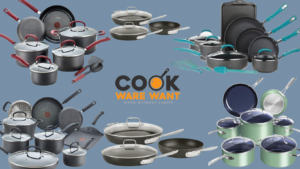
Cookware that has been hard anodized is constructed of aluminum that has gone through the anodization electrochemical process. This procedure involves immersing the aluminum in an acidic solution and applying an electrical current to it. As a result, an oxide layer forms on the aluminum’s surface, protecting it from corrosion and giving it a hard, non-reactive finish.
Construction and Properties
The remarkable longevity of cookware with a hard anodized finish is one of its main advantages. Cookware can endure the rigors of regular usage since the anodization process not only hardens the aluminum but also makes it scratch-resistant. Furthermore, the non-porous surface stops aromas and odors from absorbing, which makes it perfect for cooking a range of foods without worrying about cross-contamination.
Cookware that has been hard anodized usually has several layers. Because of its superior heat conductivity, aluminum is frequently used to create the base layer. This makes it possible for the cooking surface to have uniform heat dispersion, reducing hot spots and guaranteeing consistent cooking outcomes. The hard outer layer is then created by anodizing the aluminum core, which increases durability and resistance to abrasions and scratches.
Moreover, the cooking surface of a lot of hard anodized cookware sets has a non-stick coating. This coating, which is frequently formed of ceramic or titanium, improves the cookware’s non-stick qualities, making food release simple and cleaning a breeze.
Benefits of Hard Anodized Cookware
Durability: Cookware with a hard anodized finish is highly durable and heat-resistant, making it appropriate for a variety of culinary methods such as baking, searing, and sautéing.
Non-Stick Properties: Hard anodized cookware has a non-stick coating that keeps food from clinging to the surface, minimizing the need for additional oil or butter and simplifying cleanup.
Even Heat Distribution: By removing hot spots and ensuring even heat distribution, the aluminum core consistently produces delicious meals.
Versatility: Hard anodized cookware is a versatile option for any kitchen, since it can be used with gas, electric, or induction cooktops.
Easy Maintenance: Hard anodized cookware’s non-porous surface protects against corrosion and stains, requiring little upkeep to keep it looking like new.
Health Benefits: Hard anodized cookware is a safe choice for preparing nutritious meals because it doesn’t include any dangerous chemicals like PFOA or PTFE, in contrast to some other varieties of cookware.
Uses of Hard Anodized Cookware
Cookware with a hard anodized finish can be used for a variety of cooking methods, such as baking, simmering, and searing. Its adaptability makes it a necessary tool in any kitchen, whether you’re cooking a fancy dinner for guests or just a quick breakfast.
Some common uses of hard anodized cookware include:
Sautéing: Hard anodized pans are ideal for sautéing vegetables, meats, and shellfish because of their non-stick surface and even heat distribution.
Frying: Hard anodized skillets offer superior heat retention and reliable cooking outcomes whether it comes to frying eggs, chicken, or potatoes.
Baking: Hard anodized baking sheets and cake pans are a baker’s choice because they provide uniform browning and simple release of baked items.
Boiling and Simmering: Because of their sturdy design and non-reactive surface, hard anodized pots and saucepans are perfect for boiling pasta, preparing soups, and simmering sauces.
Grilling: You may achieve grill marks and add smokey flavors to your favorite foods indoors with some hard anodized cookware sets that contain grill pans or griddles.
Maintenance and Care
Although cookware with a hard anodized finish is thought to be long-lasting and low maintenance, regular maintenance is necessary to extend its life and maintain its functionality. The following are some pointers for maintaining your hard-anodized cookware:
Hand Washing: Always hand wash hard anodized cookware with mild dish soap and a soft sponge or cloth to prevent scratching the non-stick coating. Steer clear of abrasive scrubbers and cleansers since they may cause surface scratches.
Steer clear of High Heat: Although cookware that has been hard anodized can tolerate high temperatures, continuous exposure to high heat can harm the non-stick coating. To avoid overheating when cooking, use moderate heat settings.
Use Wooden or Silicone Utensils: Steer clear of metal utensils to avoid scratching the surface of your cookware. Instead, use silicone or wooden utensils, which are kinder to the non-stick coating.
Store Properly: Avoid nesting pieces of hard anodized cookware together while storing them to prevent scratches and damage. As an alternative, store pots and pans separately or hang them from a pot rack.
Steer Clear of Abrasive cleansers: The hard anodized cookware’s surface can be harmed by abrasive powders, scouring pads, and harsh cleansers. To maintain its beauty and functionality, use gentle cleaning agents and light detergents.
Routine Maintenance: Check your hard-anodized cookware occasionally for wear indicators like chips, scratches, and warping. To guarantee optimum performance and safety, replace any damaged components.
Conclusion
Cookware that has been hard anodized has gained a reputation as a reliable, functional, and high-quality choice for both home and professional chefs. Cooking is made more enjoyable and easier to maintain with hard anodized cookware because of its remarkable durability, non-stick qualities, and uniform heat dispersion. Hard anodized cookware brings the dependability and performance you need to enrich your culinary creations, whether you’re sautéing, frying, baking, or simmering. Purchase a high-quality set of hard-anodized cookware now to maximize your kitchen’s potential.

